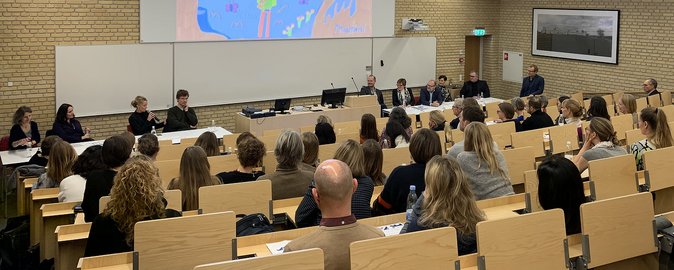- Education
-
Research
Current research
Talent
-
Collaboration
Businesses
Government agencies and institutions
Alumni
-
About AU
Organisation
Job at AU
Study abroad, stay in touch with your research group during maternity leave, create a family-friendly work culture and establish clear career paths. Both the women employed there and Health as an organisation got some good advice when the faculty held its seminar on a better gender balance in research.
2019.12.06 |

"We miss out on talent and we lose knowledge if women systematically choose not to pursue an elite research career. It’s been said before, but it needs repeating until we find solutions". Professor at the University of Copenhagen and chair of the task Danish Taskforce for More Women in Research, Liselotte Højgaard visited Health at a seminar for gender balance in research. She is flanked by Dean Lars Bo Nielsen and Professor Poul Nissen.
"When I tell colleagues abroad about our how much we lag behind with women in research, they don't believe me. How can we lag behind with women in Danish elite research in a country with so many opportunities?”
Liselotte Højgaard, professor at the University of Copenhagen and head of department at the Rigshospitalet, struck a chord at Health's seminar on research funding and equal opportunities on 27 November. As the November sky darkened ominously outside the lecture theatre in Vennelyst Park, Liselotte Højgaard put the afternoon's discussion into perspective:
"With few women in elite research, there are fewer to apply for the major grants. We need to discuss the paradox inherent in having so few women at professor and top management level in research, and find solutions that get more women up there. Because it won’t happen on its own! And we don’t have time to wait,” she said.

Liselotte Højgaard was invited to Health in her capacity as chair of the task Danish Taskforce for More Women in Research, which was set up by the previous government in 2014. The following year, the taskforce published a number of recommendations for short term measures. In the long term, the development of the gender balance does not look too bad, although patience is required.
"If we continue like this, it will be 2050 before we achieve our goal,” as Liselotte Højgaard put it. The shameful facts are that the proportion of female professors at universities is lower in Denmark than in any other Nordic country and also below the average in the EU and OECD. At Health, there are 205 professors, with 158 men and 47 women (2018 figures).
And according to Liselotte Højgaard, this is costing Denmark a lot of money:
"We miss out on talent and we lose knowledge if women systematically choose not to pursue an elite research career. Having both genders contribute with competences, creativity and experience is beneficial for research. And the quality and relevance of research is stronger when all talented researchers are nurtured. It’s been said before, but it needs repeating until we find solutions.”
Are quotas a solution? According to Liselotte Højgaard, simply having the discussion about quotas is a problem in itself.
"Quotas are an extremely emotional topic. Some people become downright aggressive in their argumentation when quotas for more women are discussed. In my experience of discussing quotas, half have been in favour and the other half against, and everyone was exhausted afterwards. It’s very complex," said Liselotte Højgaard.
She finds it important to point out that it is not the women themselves who need to be “fixed”. Organisations on all levels are responsible for creating more equality. Taking the university as an example, this can be done by: drawing up action plans; recommending qualified women for awards; highlighting female role models; having appointment committees with equal numbers of men and women; offering systematic career paths; having mentor schemes; and creating family-friendly financial opportunities for study or research abroad.
But according to Liselotte Højgaard, women also need to do something about the situation:
“Women should be careful that they’re not holding themselves back. They should make their managers aware of relevant positions and awards. While on maternity leave they should stay in contact with their research group, and also take the opportunity to travel abroad and create an international network. These are only a few means, but they can be crucial for moving your career in the right direction,” said Liselotte Højgaard.
Read more about the seminar Research funding – equal opportunities?